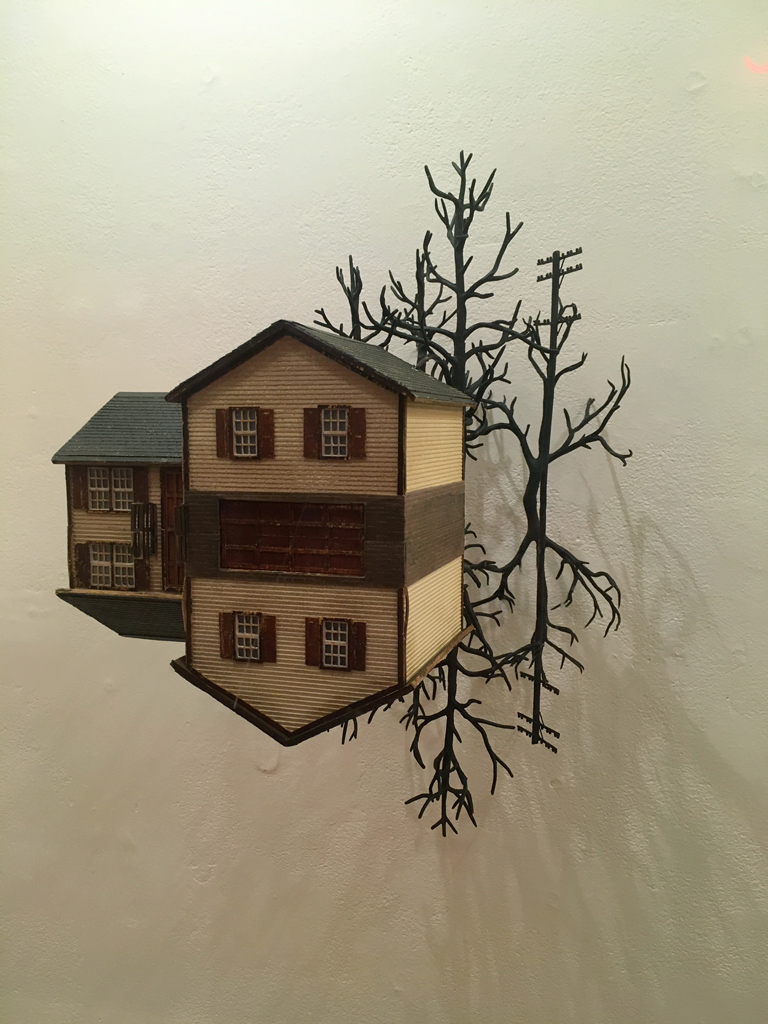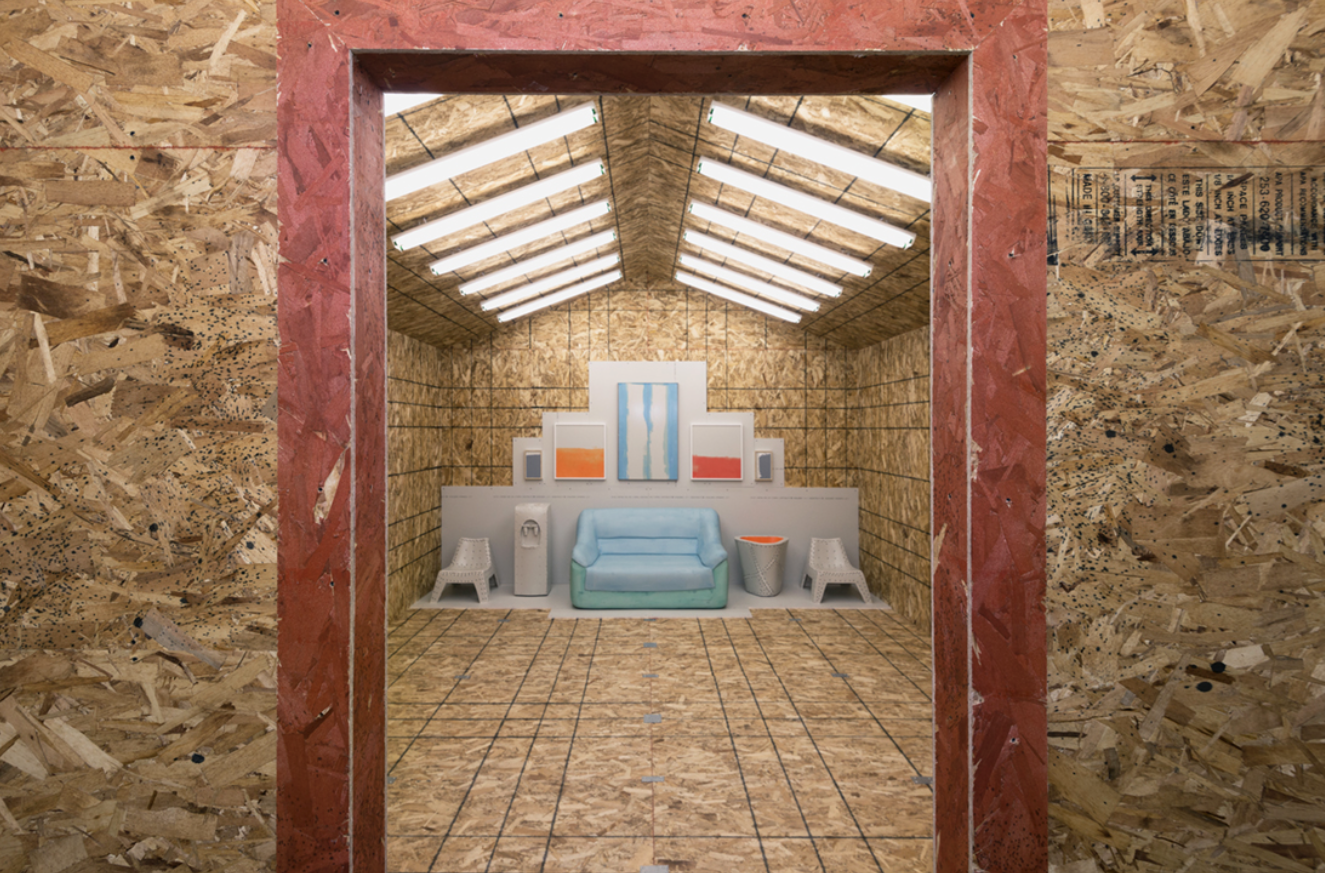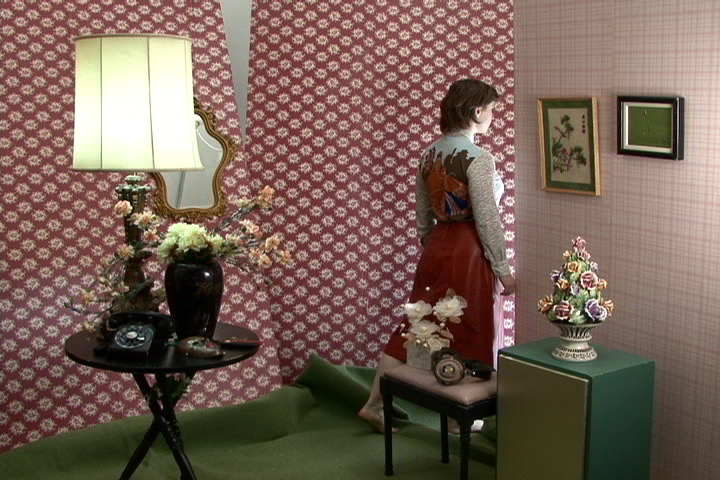Break-and-Enter:
On the Exhibition Undomesticated
January 2020
In critical response to the group exhibition Undomesticated
September 18 to November 17, 2019, Koffler Gallery @ Artscape Youngplace, Toronto
Images for footnotes appear courtesy of Koffler Gallery. Notes 1 & 3: Photography by Toni Hafkenscheid.
This is an excerpt of the text. See the full version at Peripheral Review.
The mid-century modern across the street, now composed, perfectly centered within the window of the storm door, appeared angelic and fantastically distant in its miniature state.[1]Kevin Yates, Camp Street, 2013. Bronze, painted wood. Unassuming power poles and trees were mirrored in the wetness of the street, and they seemed to extend forever, piercing the top and bottom of the frame. Paralyzed there, like a moth under glass, the image of the house was a reality unto itself. All power lines and branches led back to its door, its half-open windows. “Thus, in minuscule, a narrow gate, [had] open[ed] up an entire world,” in which details were all that mattered.[2]Gaston Bachelard. The Poetics of Space. Maria Jolas, Trans. 1958. Beacon Press, 1969, p.155. The silhouette of a radio, a spider plant descending in pairs. This was all I could focus on as I came face to face with the Intruder.
Unassuming power poles and trees were mirrored in the wetness of the street, and they seemed to extend forever, piercing the top and bottom of the frame. Paralyzed there, like a moth under glass, the image of the house was a reality unto itself. All power lines and branches led back to its door, its half-open windows. “Thus, in minuscule, a narrow gate, [had] open[ed] up an entire world,” in which details were all that mattered.[2]Gaston Bachelard. The Poetics of Space. Maria Jolas, Trans. 1958. Beacon Press, 1969, p.155. The silhouette of a radio, a spider plant descending in pairs. This was all I could focus on as I came face to face with the Intruder.
His eyes were dark and too remote for reflection. Vanishing points. Still, I couldn’t bring myself to return his shrinking gaze. He was shirtless and bedecked in beads of sweat. As the smell of adrenaline filled the vestibule, I could only look away—beyond the imminent—to the emergent tableau of a floating house. Creamed corn siding. Dusty crimson shutters. Hundred-year-old oak trees undergoing a long mitosis. Like me, the house was shipwrecked in time, unable to re-enter the current, the present. Was it a mirror? A dialectic? Was I the house, now defeated and redoubled, contained within a frame?
Neither of us were moving except for the slight swelling of breath. The intruder was eerily still like a mime; he seemed more a fixture than a person. This anti-dynamic rendered our encounter as an object for study, then hesitation, and eventually neurotic meaning-making. He was taunting me with the threat of interpretation.
Abruptly, an angry car horn shot between us. Passing headlights brought surfaces to life and his face strobed into acuity. I instinctively lurched forward and puffed up my chest.
“This is a private residence. You should go.”
I was disarmed by the politeness of my own words. How erudite. How Canadian! After a thick pause, he simply turned around. His movement was slow and deliberate, as if pivoting to place a heavy bottle on a high shelf. As he fingered the door handle, he muttered something lurid I couldn’t quite decipher. But his breath was heavy and close. Then finally, with a huff, his sinewy frame was gone. Or perhaps, it only receded.
doors and cornersMorbid curiosity settled over me after he left. You would have thought me grateful to see him go. And I was. But gnawing questions gathered on my arms and legs like cobwebs. I groped for the lights in long-neglected rooms of the house, weaving my fingers through intersecting lines of inquiry. The viscosity of darkened corners became a constant source of frustration. My questions were not the typical how the hell did he get in? I knew that already—the door was unlocked. It was late at night; I was high. A cynic might say I had it coming. But I was oddly unconcerned for my own safety. Instead, what haunted me for days afterward were questions of identity and ethos:
Not: Who was he? But: Who was he to me?
Not: What was he thinking? But: What was he thinking that I was also thinking?
Not: Where did he come from? But: Where was he headed after me? And, why?
Like a photograph, our encounter offered a proof of some kind. But it didn’t offer knowledge of his character, his origin, or trajectory. The Intruder was a network of references, but only the image—our particular intersection—was legible to me.
After examining every lock, latching them again and again—as if the act of locking was a cumulative gesture—I came to rest in the reading nook. Unlike the others, this corner of the house is always illuminated, always revealed in artificial light. Its details are not presumptuous. Rather they wear their insides out. The MDF that normally sits behind the smooth façade of drywall is exposed here and decorated in the measurements of its construction.[3]Nicolas Fleming, Une causeuse, un distributeur d’eau, un vase (2019) Bold lines of caulk reinforce the essential junctures, and these lines converge behind the back of a sky-blue sofa. From its centre, I can sit and look out onto the vastness of the main floor, my body stationery but my lines of sight infinite. No looking back—only out and through. There is something totalizing about this lookout position; an all-seeing function of the home-as-technology.[4]David Wills. Dorsality: Thinking Back through Technology and Politics. University of Minnesota Press, 2008, p. 11. Such is the power of the corner, to act as “a haven that ensures us one of the things we prize most highly—immobility. It is the sure place, the place next to my immobility” and my antithesis.[5]Bachelard, p. 137.
Bold lines of caulk reinforce the essential junctures, and these lines converge behind the back of a sky-blue sofa. From its centre, I can sit and look out onto the vastness of the main floor, my body stationery but my lines of sight infinite. No looking back—only out and through. There is something totalizing about this lookout position; an all-seeing function of the home-as-technology.[4]David Wills. Dorsality: Thinking Back through Technology and Politics. University of Minnesota Press, 2008, p. 11. Such is the power of the corner, to act as “a haven that ensures us one of the things we prize most highly—immobility. It is the sure place, the place next to my immobility” and my antithesis.[5]Bachelard, p. 137.
Who is Antithesis? Surely, not the Intruder. He and I are a dialectic. “Antithesis is a wall without a doorway.”[6]Roland Barthes. S/Z: An Essay. Richard Miller, Trans. New York: Hill and Wang, 1974, p. 65. It privileges no view. It reciprocates without reflecting any Other. This corner of mine is solely internal—solipsistic. And yet, I still don’t feel alone. Some residue of the Intruder remains, around the corners and forever just beyond my perception. Eventually, lines of sight turn to vectors of escape. I look down to see I am clenching some weathered hardback of Deleuzian theory. But even a minor critique can only operate within the confines of a major literature.[7]See “What Is A Minor Literature?” in Gilles Deleuze and Félix Guattari, Kafka: Towards a Minor Literature, University of Minnesota Press, 1986, p. 16-28. The air in the room grows thick with dichotomy, and I sink beneath its weight.
I once saw a movie like this.[8]Julie Favreau, Chambre, 2009, Video, 5:21 minutes. The viscera of a room come bearing down on a girl, and she clings to the wall in terror as if thrown by some sublime and centrifugal force. She moves slowly and painfully sideways, looking for escape. When she reaches the corner, she just keeps on moving and disappears into the seam.
The viscera of a room come bearing down on a girl, and she clings to the wall in terror as if thrown by some sublime and centrifugal force. She moves slowly and painfully sideways, looking for escape. When she reaches the corner, she just keeps on moving and disappears into the seam.
